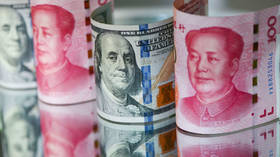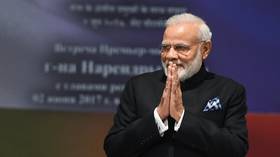India’s new foreign trade policy aims to smash dollar’s hegemony

India’s new foreign trade policy, which took effect on April 1, seeks to pivot away from the US dollar’s hegemony and promote the country’s own own national currency, the rupee, in a bid to boost exports and conserve its foreign exchange reserves.
In 2022, India’s exports were $453.3 billion, a 14.6% uptick year-on-year, despite a slowdown in global trade. India became the fifth-largest economy in the world last September at $3.18 trillion, even though the Covid-19 pandemic slowed it’s march towards $5 trillion by another two years.
Amid a robust economic growth outlook, India is poised to trade in rupees with countries that are facing an acute shortage of dollars, according to the country’s commerce secretary, Sunil Barthwal. Santosh Kumar Sarangi, head of the directorate-general of foreign trade (DGFT), has spelled out a national goal of $2 trillion in exports of merchandise and services by 2030. Additionally, India will launch a new amnesty scheme for one-time settlement of defaults on export obligations, Sarangi said. The scheme, which will remain operational till September, aims for quicker resolution of trade disputes.
Indian rupee goes global
The rupee’s global push got a shot in the arm after 18 countries including Russia, Germany, Singapore, Israel, and the UK agreed to trade in the Indian national currency. The Reserve Bank of India (RBI), the country’s central bank, recently gave its approval to these countries to pay for imported goods in rupees. The move will reduce India’s ballooning trade deficit of $233 billion between April 2022 and January 2023.
India’s trade with its south Asian neighbors such as Nepal, Bhutan, Bangladesh, and Sri Lanka will also grow as BRICS members push to de-dollarize the global market.
Last month, the Indian government announced that the RBI had cleared 60 requests from various banks in these 18 nations to open Special Vostro Rupee Accounts (SVRAs) that allow foreign banks to settle payments in rupees.
Indian importers will make payments in rupees that will be credited to the SVRAs of the foreign correspondent bank, and exporters will receive payment from the SVRAs of their foreign partners. India’s central bank has also given the nod for the surplus rupee balance in these SVRAs to be used for payments on projects and investments, import advance flow management, and investments in government securities.
The RBI’s new norms augur well for India, which holds the rotating presidency of the G20 this year. New Delhi would like to use this elite world economic club to push for international trade settlement in rupees, Barthwal said. He believes the rupee trade will help several developing and less developed economies that are facing currency issues.' A broad consensus on these lines emerged during the first Trade and Investment Working Group (TIWG) meeting of the G20 that was held in Mumbai, India in late March.
Time to end the dollar’s ‘bullying’
As economies around the world – especially emerging ones – feel the spillover effect of US monetary tightening, the debate is being reignited on ending the dollar’s dominance in global trade. Another key factor is Washington’s ability to use its currency as a potent tool for political blackmail and coercion against nations it sees as adversaries. From Cuba to Iran to Syria to Russia, the US has been accused of arbitrarily imposing sanctions on nations to further its own economic interests while pursuing irresponsible monetary policies. Several experts have cited the weaponization of the dollar as a likely trigger that could bring an end to its dominance as the world’s most powerful currency.
The call to ditch the US dollar has intensified following US sanctions on Russia due to the Ukraine conflict that started in February 2022. The punitive measures led to overseas assets of Russia’s financial institutions being frozen and multiple major Russian banks being cut off from the SWIFT system. This was an indication for the rest of the world, including India and China, of the growing risks of the US using the dollar for its geopolitical and expansionist gains. A new arrangement is needed, and currencies such as the Chinese yuan have an opportunity to play an important role in providing such an alternative.
Plans are afoot by many nations to ensure the SWIFT system becomes less relevant through innovative financial mechanisms that are gathering momentum. These measures would limit the system as a tool for the US and its coercive tactics. For instance, during the meeting of all ASEAN finance ministers and central bank governors in Bali, Indonesia on March 30, topping the agenda were discussions about reducing financial transaction dependence on the US dollar, euro, yen, and pound sterling and alternatively making payments in regional currencies.
In January, South African Foreign Minister Naledi Pandor was quoted as saying in an interview with Sputnik that the emerging economies of BRICS would like to find a way of bypassing the US dollar and creating a mechanism that would not be skewed towards wealthier Western nations. Saudi Arabian Finance Minister Mohammed Al-Jadaan echoed Pandor in January, saying the oil-rich sheikhdom would be open to talks about settling petroleum trade in currencies other than the US dollar.
Not so rosy for rupee-ruble trade
Though India has been working overtime to push the rupee for its global trade, the realities are far from ideal, as the currency has considerably weakened in the past year.
In the case of India-Russia bilateral trade, which has been rapidly growing since the Ukraine conflict started, New Delhi has found a viable alternative.
India and Russia have decided to route goods through third countries such as the UAE, which enjoys healthy ties with both the nations, and also because the emirates’ currency – the dirham – is pegged to the dollar, and as a result, the dirham enjoys global stability. Both nations have come to the understanding that this is the best way to engage in bilateral trade and also avoid trading in rupees, rubles and dollars.
However, the new approach contradicts the Indian government’s bid to settle international trade in rupees in line with an announcement made last July.
The rupee-ruble payment mechanism is proving to be tough going so far because of the growing trade imbalance between India and Russia and several other teething issues. Russian banks such as Sberbank and Gazprombank, which have operations in India, are also not in favor of Indian rupees piling up.
Besides, the rupee lost 7.8% in the last financial year, the most since 2019-20, and it was one of the worst performing Asian currencies – falling more than 10% – in 2022. It ended this past fiscal year in March at 82.18 to a dollar. Given such volatility, using the UAE dirham appears to be a reasonable solution to help facilitate a further ramping up of bilateral trade.
Foreigners less enthusiastic about US debt
Another important area where de-dollarization trends are being observed is American debt. While statistics on foreign holdings of US Treasuries for any given month or even year may simply reflect the vicissitudes of markets and the relative strength of the dollar, the long-term secular trend is of foreign central banks scooping up less American debt than they once did.
For decades, foreign countries sterilized a significant share of US deficits – meaning the US ran deficits that it financed with dollar-denominated debt, which other countries bought in large quantities. However, this arrangement – a key component of the special status the dollar has enjoyed – has begun being chipped away at in recent years. In fact, since 2014, foreigners have been consistent net sellers of Treasuries.
Prominent American fund manager Luke Gromen has noted that between 2002 and 2014, foreign central banks bought 53% of all US Treasuries issued; from 2014-2022 that figure is just 3%. China, in fact, announced in 2013 that henceforth it would not grow its balances of US Treasuries and has been a net seller of Treasuries for over a decade.
This trend is likely set to continue. And with less trade being settled in dollars, there will be fewer dollars to be recycled into traditional reserve assets such as US Treasuries.
De-dollarized global trade
India and China have initiated the move to de-dollarize global trade with Russia, while Brazil is joining the party and South Africa is waiting in the wings. The initiative connects the BRICS trade dots. India has paid Russia in UAE dirhams for its crude oil purchases and saved an estimated $3.6 billion in the process.
The yuan has in recent years established itself as a major global currency that is poised to contribute to the dislodging of the dollar from its position of supremacy. The yuan is now the fifth most used currency in payments, third largest in trade settlements and fifth largest reserve currency.
To make matters worse for several developing countries, there has been an exponential rise in dollar borrowing costs, holding back the growth of their foreign trade. This is where comparatively low-cost yuan financing could further boost the Chinese currency’s global visibility.
The yuan joined the IMF's Special Drawing Right (SDR) basket in October 2016, and since then the currency’s strength has grown significantly. IMF data showed that yuan accounted for 12.28% of the SDR last year.
With Beijing working overtime to make a currency play as the world’s second-largest economy, the prevailing dollar-dependent scenario could change in the next couple of years. China’s Cross-Border Interbank Payment System (CIPS), which is a viable alternative to SWIFT, and its digital currency (e-CNY) promises to become a dominant payment system to further trade between Beijing and its partners such as the Global South. The e-CNY could emerge as the significant reserve currency, which would break the dollar hegemony.
The Indian rupee could double down as a foil to the Chinese currency in a multipolar world. De-dollarization is likely to become a reality in a new global order, where the US won’t have the last word based on its economic might.
Historically, it’s the decline of the currency that portends the decline of hegemony. And the dollar could be the epitaph for US imperialism.
The statements, views and opinions expressed in this column are solely those of the author and do not necessarily represent those of RT.















